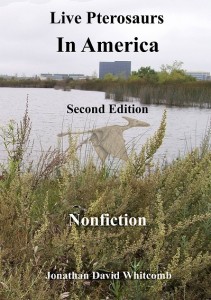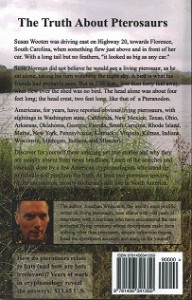Having just passed the one-year anniversary of Pterosaur Eyewitness, we can consider the best posts of the past twelve months. I hope that the next year will see more comments from readers.
A brief look at eyewitnesses of living pterosaurs
Consider Papua New Guinea. For Umboi Island, eyewitnesses have included an Australian who served in a government position there, a native government leader, many common villagers, and a visiting cryptozoogist. For other areas of P.N.G. [Papua New Guinea], they have included an Australian psychologist, American expedition members of a television true-life adventure series, an American World War II soldier, a British entomoligist (biologist), missionaries, a non-missionary visiting a mission, many common villagers, a minister, and a visiting cryptozoologist.
.
Living Nightmare: Attack in the Dead of Winter
A strange interpretation of the Marfa Lights of Texas (this is speculative)
Remember your worst nightmare? Were you glad to wake up? Be grateful. In the early morning hours of February 23, 2010, a few miles or so southwest of Marfa, Texas, the victims were terrified by what awakened them. I am not the eyewitness, but a few days after this event, I interviewed my friend James, who had been driving through Southern Texas . . .
James did not actually see the carnage. In fact, the attack I am about to describe might be only in my imagination . . . my friend saw only strange lights, flying above the fields where countless spectators, for many years, have observed the dancing Marfa Lights. But this night was different.
What could be worse than any nightmare? In the dead of night, you are awakened by what you fear most, glaring down at you. To humans, this monster should not even exist except in a dream. This one is real. Race out of your bedroom; it’s after you. Race out the front door; it follows. Search for a place to hide; it’s too late. You are exposed, surrounded by many monsters ready to feast. You have fallen into their trap. Your family is scattered, chased across the freezing countryside. You are alone. You are Eptesicus fuscus, a Big Brown Bat.
.
Duane Hodgkinson, “Pterodactyl” Eyewitness
Brief background on the World War II veteran
Like most American soldiers who began serving in World War II, Duane was hardly more than a boy. But he had been [on a farm] in his teenaged years in Ohio. His experience with the animals and farm yard probably helped him to have a feel for distance and size in the outdoors. . . . a weather observer for the field artillery in 1944 . . . Duane was trusted with that assignment. When he and his army buddy saw something fly up into the air, on the other side of the field where they stood, they could not very easily make any big mistake in estimating the size of the field: about 100 feet across. With no obstruction, Duane was able to make an estimate of the size of the strange creature that flew up and out of the field: The wingspan was about that of a small private airplane. Sometime after his military service, Duane was able to obtain a Piper Tri-Pacer and he later compared the wingspan of the “pterodactyl” with that plane’s wingpan; it was similar [a little less than thirty feet].
.
Problems With a Bat Interpretation
Includes a brief excerpt from a scientific paper in a peer-reviewed journal of science
[Critics have suggested that sightings] were of the fruit bat called the “flying fox” . . . But that bat has a maximum wingspan of 6 ft, and the best sightings that we have investigated include wingspan estimates that range from “at least 2 m, probably more” (Hennessy) to “30 and 50 ft” (Perth couple). The bat has almost no tail, unlike the reported tail of “at least 10–15 ft” (Hodgkinson) or “7 m” (G. Koro). It has no head crest, nor does it glow at night.
.
Long-tailed pterosaur seen by Susan Wooten
A number of other web pages include parts of Susan Wooten’s testimony of what she observed flying over the highway in South Carolina years ago. It’s important to consider related eyewitness accounts, for some critics have sought to simply dismiss this account as if it were an anomaly. But many Americans have reported similar creatures . . .
.
Bulverism and Pterosaur Sightings
Reasoning or lack thereof, regarding eyewitness testimonies
Some time ago, the respected cryptozoologist Loren Coleman wrote a blog page about my investigations of reports of apparent living pterosaurs in the United States. Comments poured in, mostly negative towards the possibility that eyewitnesses were seeing actual pterosaurs. Coleman himself ran off topic, with several paragraphs about John C. Whitcomb’s book (I am not closely related to that author . . .)
.
Pterosaurs in Kansas and Arkansas
From the nonfiction book Live Pterosaurs in America
It was probably 1982 when me and my older brother were sitting in our carport [in Texarkana, Arkansas] It was getting dark but there was plenty of light in the sky when we saw what we believe to be a pterodactyle [pterosaur]. The wingspan seemed to be about 25’ to 30’ ft wide . . .
.
Flying Under the Radar in Marfa, Texas
Nocturnal flying predators, maybe even pterosaurs, in Texas
What is the best hiding place for what may be living pterosaurs near Marfa? It’s probably not the caves that are said to be scattered around the old volcanic landscape, nor the suspicions of ranchers who don’t like trespassers, nor the dark of night, nor low flights of the predators. What best hides possible pterosaurs near Marfa is Western dogma about dinosaurs and pterosaurs becoming extinct millions of years ago: universal extinction dogma.
.
Bioluminescent Pterosaurs in America
Sightings of strange flying creatures at night, glowing creatures in North America
Glowing “pterodactyls?” In North America? Non-extinct? What could be more strange? Before dismissing the idea, consider some eyewitness sightings in North America, in light of reports of glowing pterosaurs in the southwest Pacific.
.
Reasons for considering Marfa Lights are from living organisms
While reading Hunting Marfa Lights (for the second time, it’s a great book), I was struck by an account of a flying “ML” (mystery light) that Mr. Bunnell witnessed in November of 2002. The light was flying where there was no road, and fast enough that it could not have been any vehicle off-road. He noticed that the light went out two or three times, remaining off for a few seconds at a time. What caught my attention was Bunnell’s impression (on page 67) of the reappearance of the light: It “would begin with a brilliant flash of light as if the ML was somehow recharged while in an off state.”




